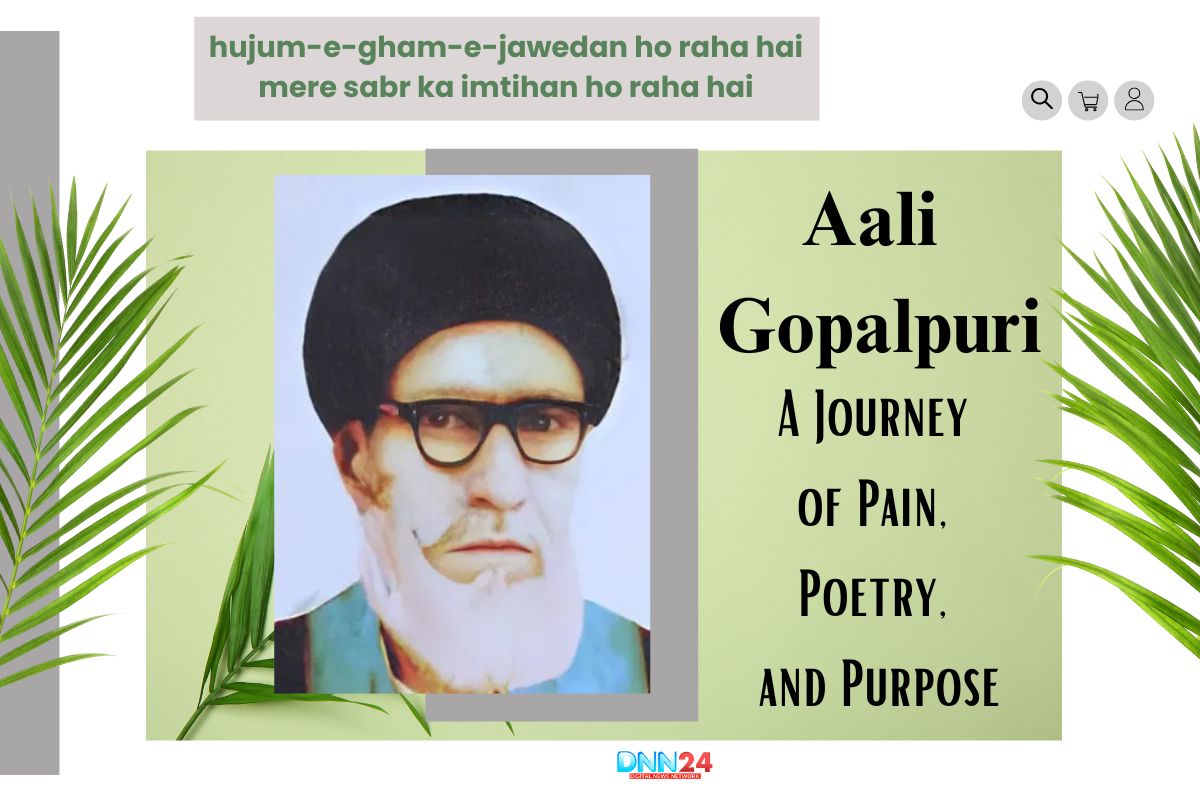Aali Gopalpuri’s story begins not in stardom, but in the quiet, often lonely alleys of Balrampur, Uttar Pradesh. He was born in 1912, as Syed Ali Rizvi Aali and his steps were gentle on the ground but resounding in the corridors of the heart. The displacement characterized his early life, as he moved out of Iraq to India, an act that came with a reminder of displacement and nostalgia for the lost sceneries.
tujh ko dekhe ek zamana ho gaya
Aali Gopalpuri
zahr ab to aab-o-dana ho gaya
Separation, not only of place but even of, it often appeared, the warmth which most children take as a matter of course, was acutely felt by Aali as a boy. His own house was not always paradise; he observed, he understood, and he silently hoarded all the twinges and delights, which would subsequently make their inexplicable way into the emotional depth of his ghazals.
ishq jine ka bahana ho gaya
Aali Gopalpuri
dam tha qismat se dana ho gaya
What nobody says: There was silence before poetry. Sighs were all there were before words. The death of loved ones, the feeling of not having open arms, and the search for a belonging that never came defined Aali in a manner that the few could not comprehend. Nightly, the young Aali sat by a mud lamp, and watched its flicker, and wondered why life had brought some the sun and left others with only sparks. But each hurt was a well–down deeper, down darker,–but yet, richer to his poetic soul to draw upon.
muskura kar tu rawana ho gaya
Aali Gopalpuri
meri wahshat ka bahana ho gaya
Zindagi Ek Dard-o-Gham Ka Saaz Hai: The Strings of Sorrow and Song
Listen, you must listen, Aali does not sing her ghazals, she confesses; she whispers, and the whispers become comfort. One of his most resonant lines, “Zindagi ek dard-o-gham ka saaz hai” (“Life is an instrument of pain and sorrow”), did not emerge from a vacuum. It is as true as the scars that do not heal. Neighbours say that when Aali wrote this, he had not eaten in days, not only grieving the death of a friend but also the miseries of a whole community devastated by war and loss.
zindagi ek dard-o-gham ka saz hai
Aali Gopalpuri
maut jis ki aaKHiri aawaz hai
Aali was hurt; ink was his blood; the page was his memory. On one occasion, when his house was searched in a political storm, he spent some hours in the debris looking at the shattered walls. One night, he started scribbling lines on a piece of torn cloth–this scrap was afterwards the first verse of one of his most affecting ghazals. Had you ever read his nazms of lost children and mothers, and how they were written by real faces that he saw daily, as he walked the streets, and as their hopes were darkened with hunger? His poetry was not merely personal; it was an account of all the heartbreaks that he had seen.
wan to aaina hai mashq-e-naz hai
Aali Gopalpuri
muntashir yan zindagi ka saz hai
The Friendless Moon: Tales Behind Unheard Verses
Aali Gopalpuri’s verses are filled with the imagery of lonely moons and silent nights. But why the moon, poor moon alone and lonely? As a young student, one night Aali spent some hours on the rooftop staring at the unchangeable moon, feeling totally friendless. On a certain evening, he came upon a lost bird with a broken wing–he nursed it till sunrise. The companionship of their silence, the short-lived relief, gave him the idea of one of his most popular of couplets, of finding in the castaways of the world, a kinship.
dil hamara dard se KHali na kar
Aali Gopalpuri
ye hamari zindagi ka raaz hai
Another story that has not been told: In a terrible flood in Balrampur, Aali was on a raft, reciting verses to frightened villagers who were stranded by the flood waters. They only had his words to cling to–shreds of hope in a monsoon of despair. These lines formed the kernel of his poetic philosophy: that in the greatest disaster, words may row souls to salvation. It’s said that the ghazal he read that night, speaking of unsung battles and unseen tears, was scribbled with trembling hands on the back of a ration card.
aaj phir barsenge naghme bazm mein
Aali Gopalpuri
aaj phir hathon pe us ke saz hai
The Healing Touch of Words: Suffering to Universal Comfort
Aali Gopalpuri always believed that poetry’s greatest purpose was to heal. He was sensitive to the problems of others because he was broken himself. He would roam hospital corridors, scribbling verses for strangers and leaving little notes under patients’ pillows—lines like “Mil gayi dard ki dawa dil ko” (“The heart found a cure for pain”). These were not mere metaphors; they were instances when Aali comforted people with the balm of his Shayari.
mil gai dard ki dawa dil ko
Aali Gopalpuri
rakhe allah mere qatil ko
In the bazaars, he’d often encounter widows and orphans; instead of mere charity, he would compose nazms that dignified their suffering and offered hope. An outstanding event: one winter was so cruel, and Aali collected some low-income families, and read them a nazm about their strength. The work would later end up in classrooms, and generations would learn about compassion not as pity but as poetic action. His words were used to patch up scars caused by the separation of Partition and the mundane horrors of poverty through poetry recitals and basic chats.
ishq ne dagh wo diya dil ko
Aali Gopalpuri
aa gai sharm mah-e-kaamil ko
The Heartbreak Secret: How Heartbreak was Anthem
Aali Gopalpuri’s legacy is, above all, a victory of spirit over suffering. He would often say, “Laga ke dil kabhi aansu bhi hum baha na sake” (“Even after attaching my heart, I couldn’t shed tears”), capturing the ache of those who must be strong when the world demands it.
The untold story: Aali closed himself off after the death of his wife and did not want to write. But a young fan, who is also a survivor of personal tragedy, pleaded with him in a letter: “Without you writing, how can we ever get closure on our sadness?” Inspired to the point of speechlessness, Aali resumed poetry the following day, writing one of his most famous nazms on revival and hope.
laga ke dil kabhi aansu bhi hum baha na sake
Aali Gopalpuri
lagi jo aag jigar mein use bujha na sake
His strength was not an act but an authentic one, nurtured in the fissures of the shattered dreams. Every poem was a brick in the shelter he created for other people. Activists, teachers, lovers and even enemies took shelter in his lines, and most of them never realized that the lines they were holding to were lines that were written during nights when Aali himself was floating, not sure whether he would see light in the morning or not.
kiya zaif tere qasd-e-justuju ne hamein
Aali Gopalpuri
ki ta-lahad bhi hum apne qadam se ja na sake
The Lasting Gift: Why Aali Gopalpuri Still Matters
Decades after his passing in 1980, Aali Gopalpuri’s voice echoes everywhere. Not just in libraries or literature festivals, but in everyday battles and victories. Why is his story unique? He did not merely make his pain poetry, but wrote himself–and millions of others–back to the edge time after time. In all the untold stories hidden between his ghazals, there is a lesson: Suffering is a well, which may not necessarily drown you; sometimes, it may bring the sweetest songs.
bahaar aai hai aalam mein ajab wahshat ka saman hai
Aali Gopalpuri
bayaban mein kabhi ghar hai kabhi ghar mein bayaban hai
There are discussions of the greatness of shayars, but that is not what Aali did; that was not his magic, because he made the grand very personal. He did not create words alone, but the lifelines, and he left his readers with the question that will always be there: Will you still sing after the storm? For all who say yes, Aali Gopalpuri is both a torch and a balm—a poet whose unheard stories still shape the songs of healing, courage, and boundless hope.
Also Read: Munawwar Rana: The Poet Who Wrote the World’s Tears
You can connect with DNN24 on Facebook, Twitter, and Instagram and subscribe to our YouTube channel.

